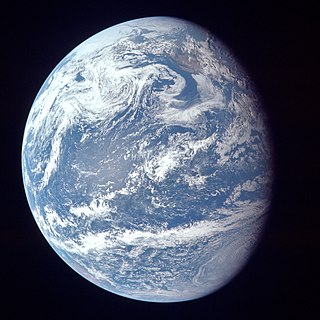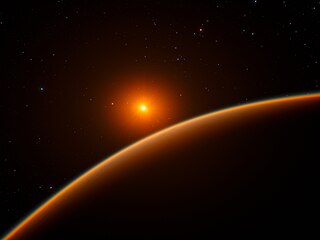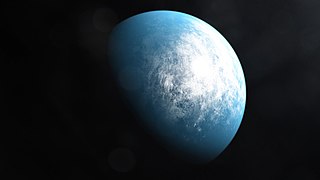
An ocean world, ocean planet or water world is a type of planet that contains a substantial amount of water in the form of oceans, as part of its hydrosphere, either beneath the surface, as subsurface oceans, or on the surface, potentially submerging all dry land. The term ocean world is also used sometimes for astronomical bodies with an ocean composed of a different fluid or thalassogen, such as lava, ammonia or hydrocarbons. The study of extraterrestrial oceans is referred to as planetary oceanography.
Pi Mensae, also known as HD 39091, is a yellow dwarf star in the constellation of Mensa. This star has a high proper motion. The apparent magnitude is 5.67, which can be visible to the naked eye in exceptionally dark, clear skies. It is nearly 60 light-years away. The star is slightly larger than the Sun in terms of mass, size, luminosity, temperature and metallicity, and is about 730 million years younger. It hosts three known planets.

Transiting Exoplanet Survey Satellite (TESS) is a space telescope for NASA's Explorer program, designed to search for exoplanets using the transit method in an area 400 times larger than that covered by the Kepler mission. It was launched on 18 April 2018, atop a Falcon 9 launch vehicle and was placed into a highly elliptical 13.70-day orbit around the Earth. The first light image from TESS was taken on 7 August 2018, and released publicly on 17 September 2018.

An exoplanet is a planet located outside the Solar System. The first evidence of an exoplanet was noted as early as 1917, but was not recognized as such until 2016; no planet discovery has yet come from that evidence. What turned out to be the first detection of an exoplanet was published among a list of possible candidates in 1988, though not confirmed until 2003. The first confirmed detection came in 1992, with the discovery of terrestrial-mass planets orbiting the pulsar PSR B1257+12. The first confirmation of an exoplanet orbiting a main-sequence star was made in 1995, when a giant planet was found in a four-day orbit around the nearby star 51 Pegasi. Some exoplanets have been imaged directly by telescopes, but the vast majority have been detected through indirect methods, such as the transit method and the radial-velocity method. As of 1 May 2024, there are 5,662 confirmed exoplanets in 4,169 planetary systems, with 896 systems having more than one planet. This is a list of the most notable discoveries.

Planet Hunters is a citizen science project to find exoplanets using human eyes. It does this by having users analyze data from the NASA Kepler space telescope and the NASA Transiting Exoplanet Survey Satellite. It was launched by a team led by Debra Fischer at Yale University, as part of the Zooniverse project.

LHS 1140 is a red dwarf in the constellation of Cetus. Based on stellar parallax measurement, it is 48.8 light-years away from the Sun. 'LHS' refers to the Luyten Half-Second Catalogue of stars with proper motions exceeding half a second of arc annually. The star is over 5 billion years old and has only about 18% the mass of the Sun and 21% of its radius. LHS 1140's rotational period is 130 days. No flares have been observed.

Proxima Centauri c is a controversial exoplanet candidate claimed to be orbiting the red dwarf star Proxima Centauri, which is the closest star to the Sun and part of a triple star system. It is located approximately 4.2 light-years from Earth in the constellation of Centaurus, making it, Proxima b, and Proxima d the closest known exoplanets to the Solar System.
TOI-677 b is a confirmed "warm" super-Jupiter exoplanet orbiting TOI-677, its host star, in the Ophiuchus constellation, about 466 ly (143 pc) away from Earth. The planet was discovered by NASA's Transiting Exoplanet Survey Satellite (TESS) using the transit method, in which the dimming effect that a planet causes as it crosses in front of its star is measured. Discovery of the exoplanet was announced on 13 November 2019.
TOI-700 is a red dwarf 101.4 light-years away from Earth located in the Dorado constellation that hosts TOI-700 d, the first Earth-sized exoplanet in the habitable zone discovered by the Transiting Exoplanet Survey Satellite (TESS).

TOI-700 d is a near-Earth-sized exoplanet, likely rocky, orbiting within the habitable zone of the red dwarf TOI-700, the outermost planet within the system. It is located roughly 101.4 light-years (31.1 pc) away from Earth in the constellation of Dorado. The exoplanet is the first Earth-sized exoplanet in the habitable zone discovered by the Transiting Exoplanet Survey Satellite (TESS).
LTT 3780, also known as TOI-732 or LP 729-54, is the brighter component of a wide visual binary star system in the constellation Hydra. This star is host to a pair of orbiting exoplanets. Based on parallax measurements, it is located at a distance of 72 light years from the Sun. LTT 3780 has an apparent visual magnitude of 13.07, requiring a telescope to view.
TOI-561 is an old, metal-poor, Sun-like star, known to have multiple small planets. It is an orange dwarf, estimated to be 10.5 billion years old, and about 79% the mass and 85% the radius of Sol, Earth's sun.
L 98-59 is a bright M dwarf star, located in the constellation of Volans, at a distance of 10.608 parsecs, as measured by Gaia.







